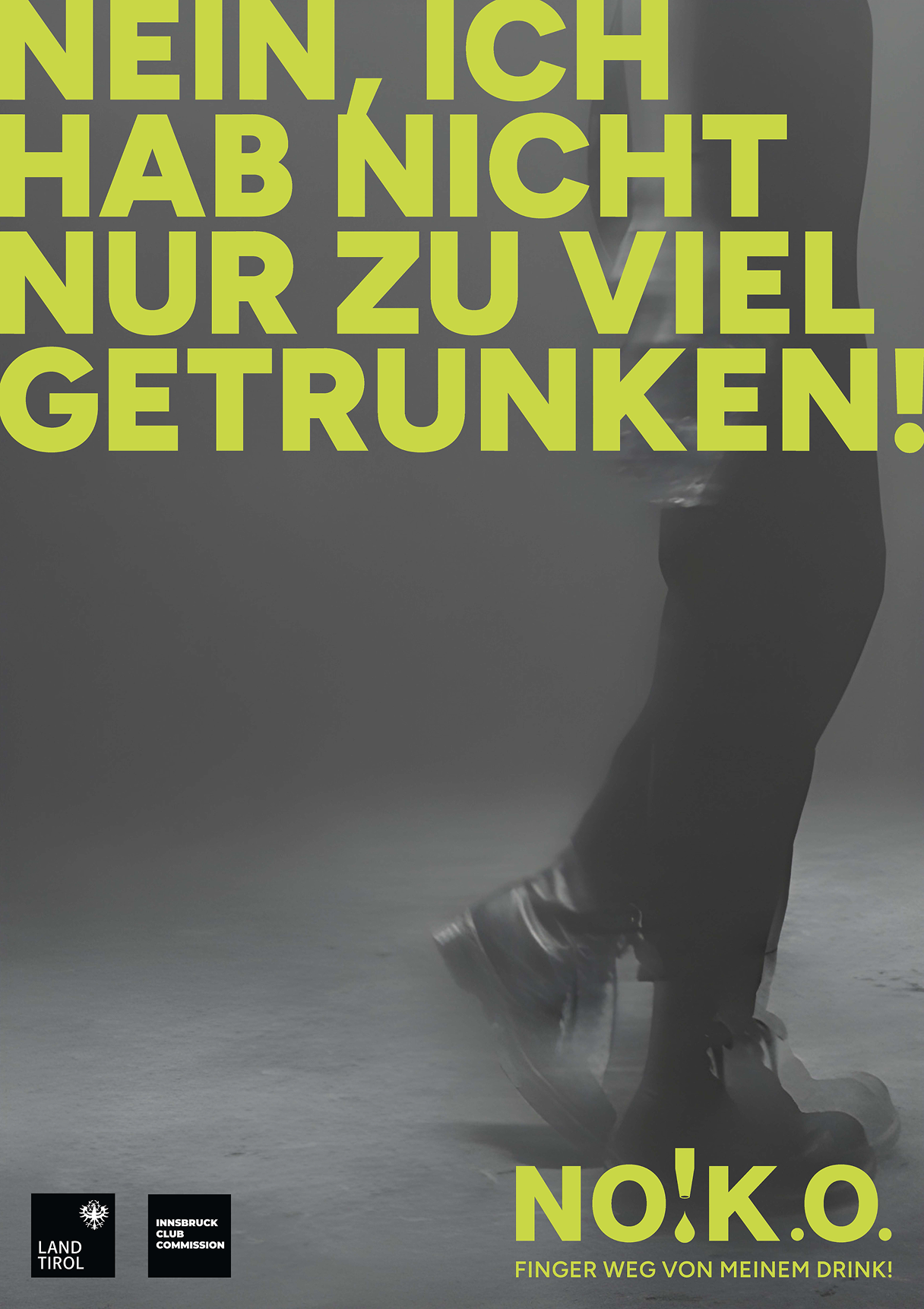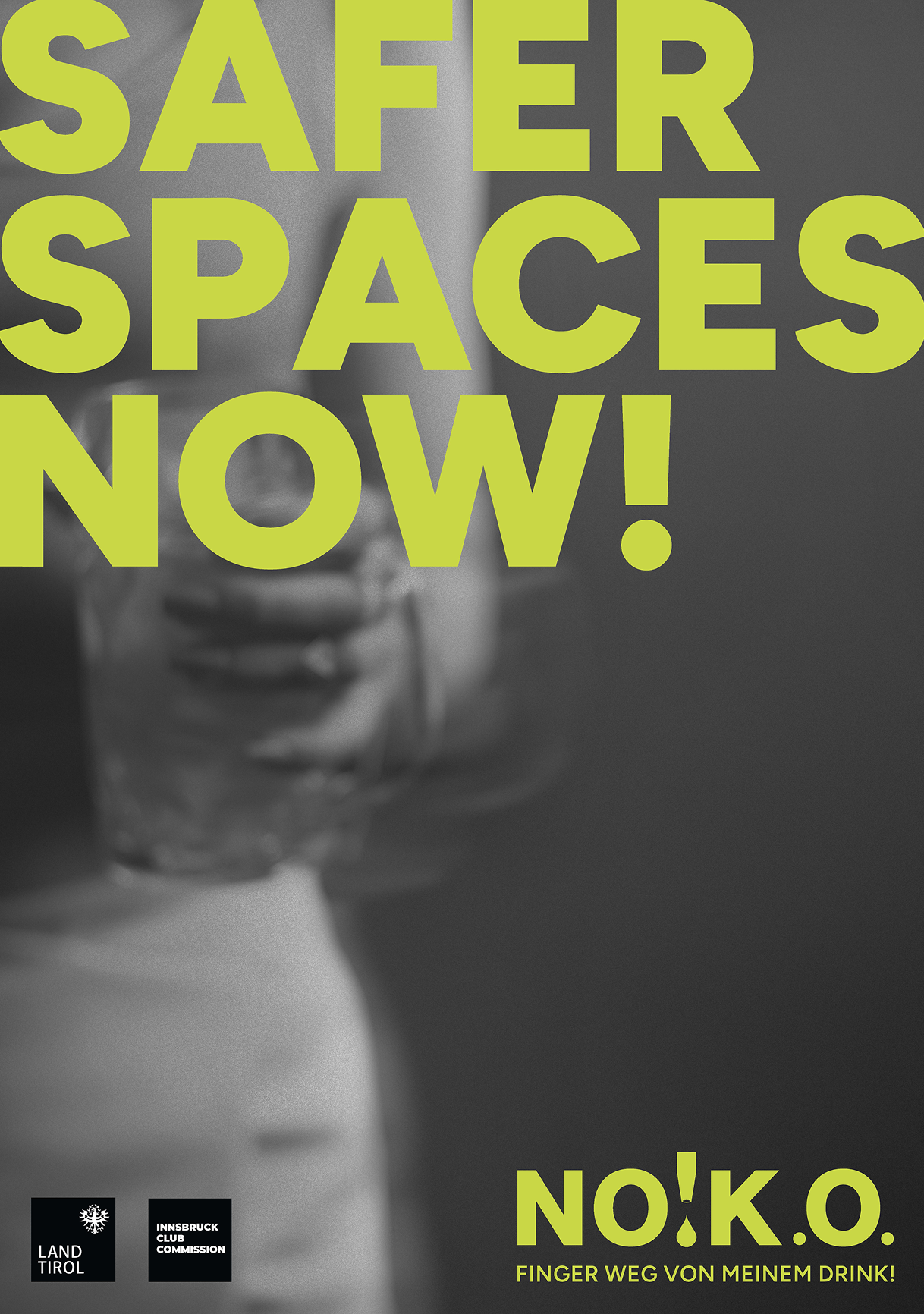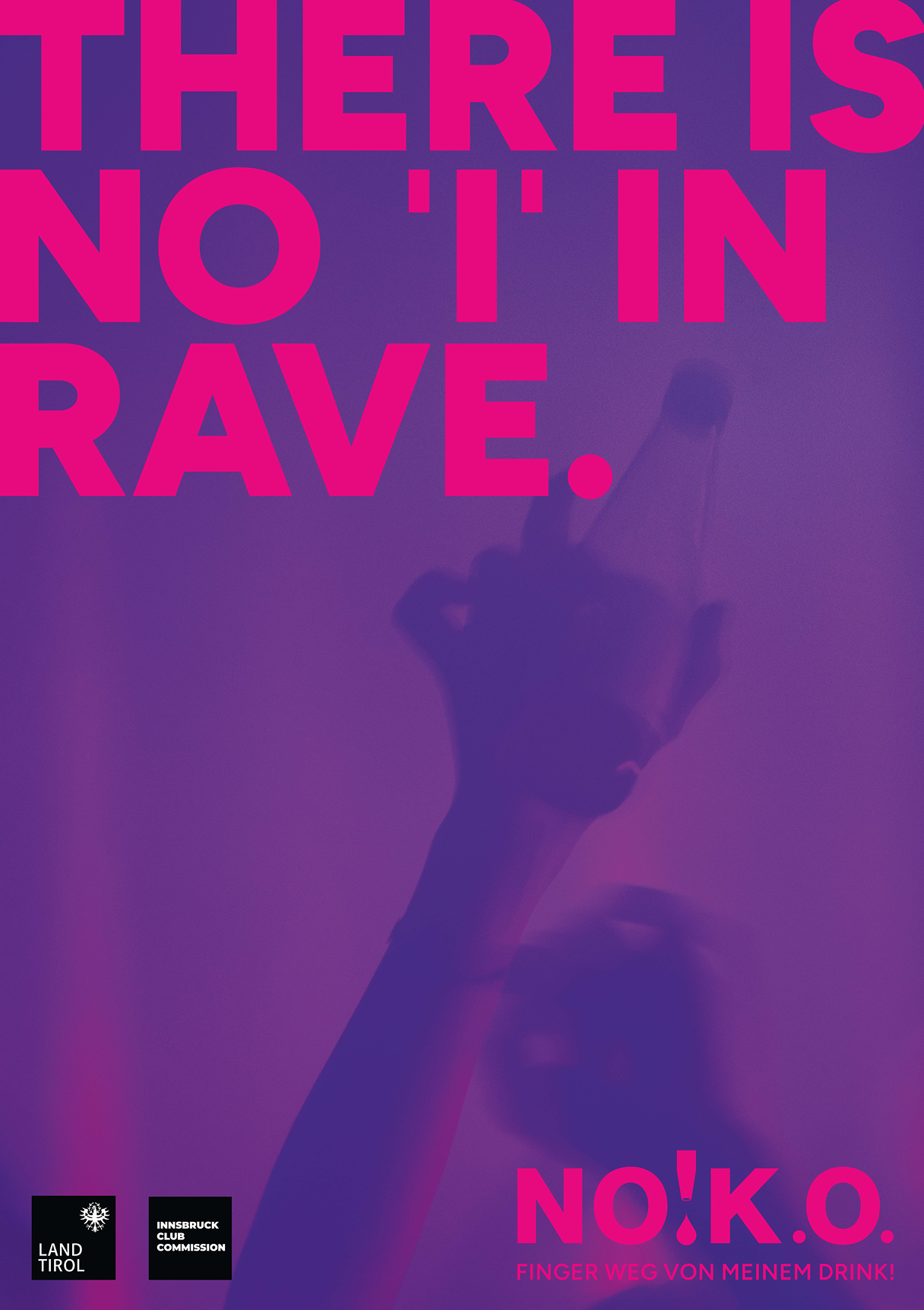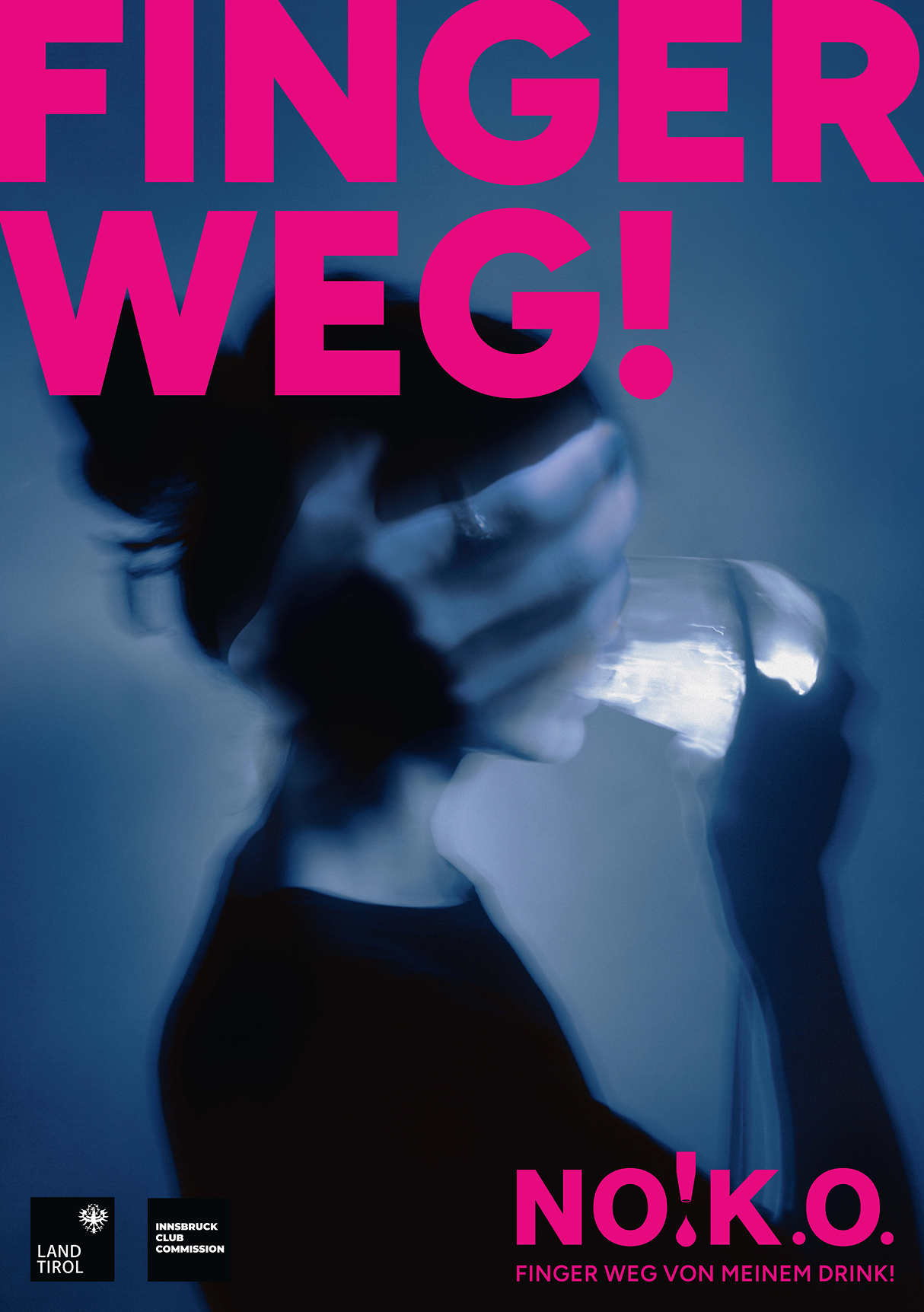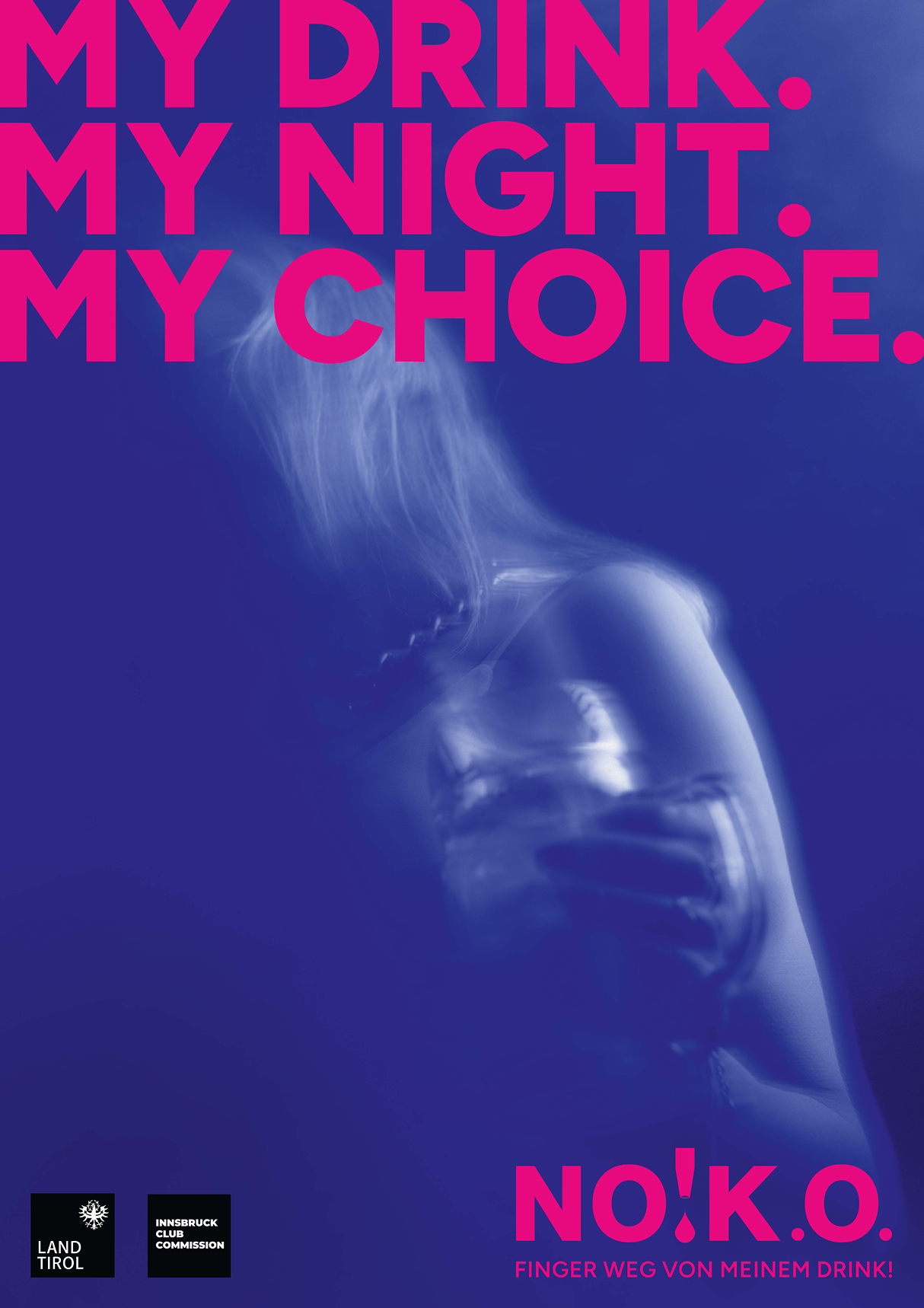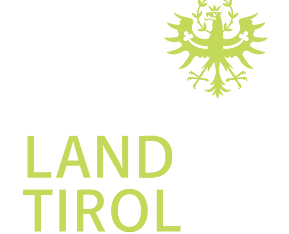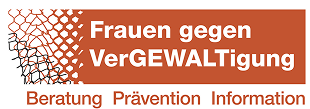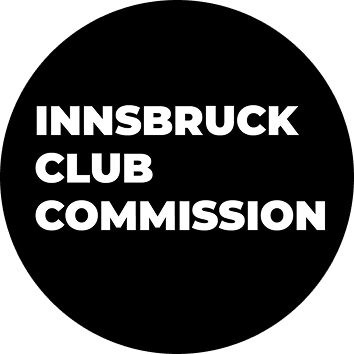HAVE A
GOOD
NIGHT

HAVE A
GOOD
NIGHT


The smarter way
to live it up

Vibes High,
Risks Low.
The initiative NO!K.O. stands against any form of spiking. We raise awareness,support those affected, and educate about the risks and impacts of this form of violence. Our mission is to help shape a nightlife where everyone can feel safer, happier and more empowered.
'Spiking' and Incapacitating Substances
'Spiking' and Incapac-itating Substances
The term "spiking" refers to the administration of drugs, usually a type of sedative, without the knowledge or consent of the affected person. These substances are used to incapacitate and render individuals defenseless. A variety of drugs can be used as incapacitating substances, with effects and detectability varying depending on the type and dosage. In many cases, such spiking incidents are followed by abusive behavior.
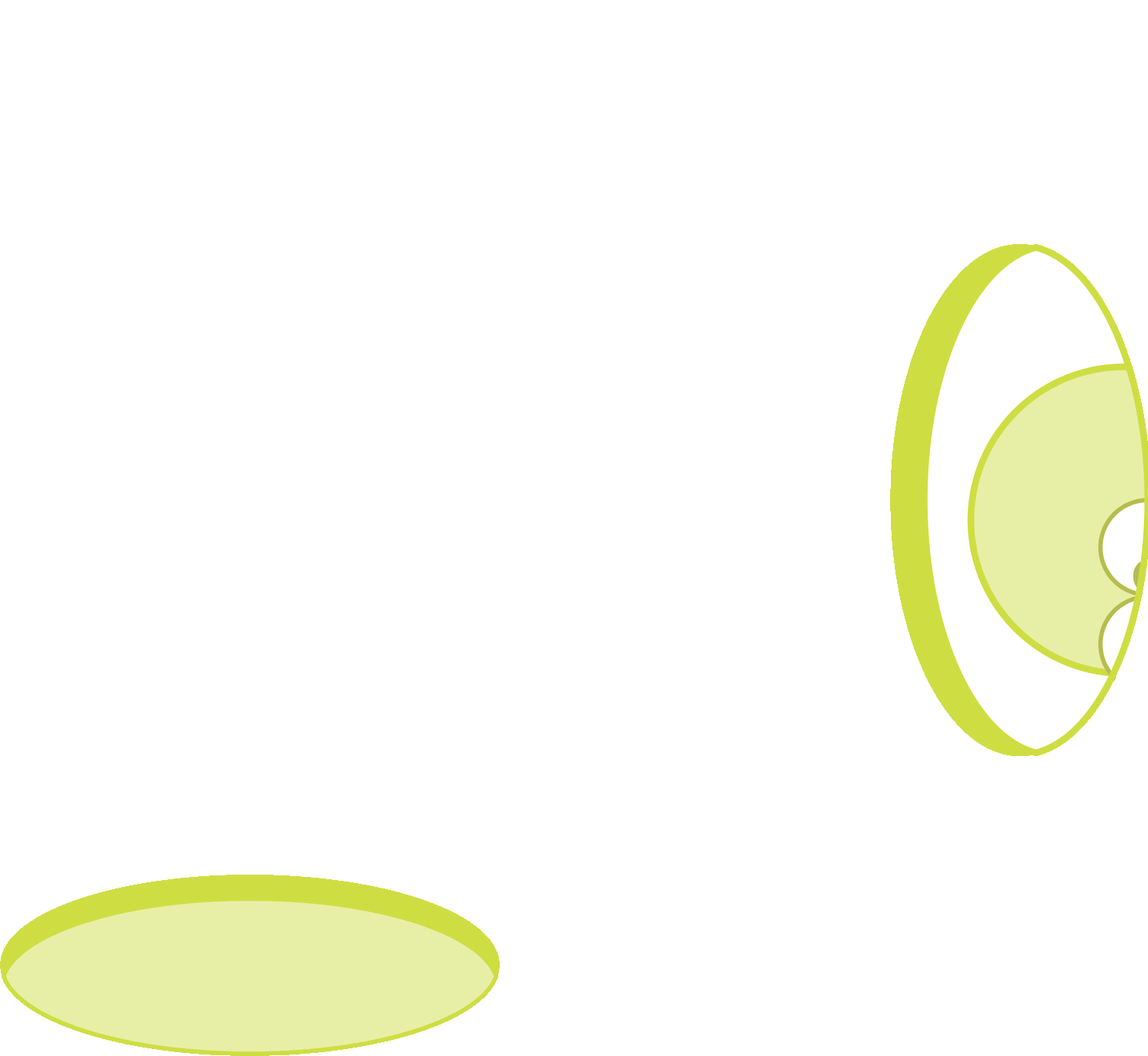

What Substances Are Involved?
Incapacitating substances used for spiking, are psychoactive drugs that act on the central nervous system, typically inducing a sedative or narcotic effect. There is a wide range of such substances, most of which are relatively odorless, colorless, and tasteless, making them easy to administer discreetly in mixed drinks.
Commonly used substances include GHB and GBL, ketamine, various opioids, and benzodiazepines. The surreptitious addition of alcohol without the affected person’s consent is also considered spiking, as it constitutes non-consensual administration aimed at impairing the individual’s control and ability to act.
While alcohol is the most frequently used substance in spiking incidents, GHB (gamma-hydroxybutyric acid) and GBL (gamma-butyrolactone) are the most prominent substances associated with spiking. GHB is classified as a narcotic and has been regulated under Austria’s Narcotic Substances Act since 2002. Ketamine, initially developed as an anesthetic, is also increasingly misused as an incapacitating substance.
Some of these substances are consumed recreationally. If you want to learn more about SAFER USE of drugs, you can find essential information here.
Show more
Show less

INTAKE and
Effects
Spiking substances are drugs used to render a person unconscious, defenseless, and incapable of action, thereby facilitating abusive behavior. While anyone can be impacted by such incidents, this form of violence disproportionately affects women and girls.
These substances can be administered in liquid or powder form, with effects typically beginning 10 to 20 minutes after ingestion. The effects vary widely depending on the type and dosage of the substance and the individual factors of the person affected. Common symptoms include loss of control, balance issues, muscle spasms, visual disturbances, nausea, severe confusion, memory loss, immobility, blackouts, and unconsciousness.
In nightlife settings, excessive alcohol consumption often blurs boundaries. Perpetrators exploit this scenario by administering substances in conjunction with heavy drinking. The combination of such substances and alcohol is particularly dangerous, significantly increasing the risk of heart arrhythmias, respiratory depression, and other life-threatening conditions. Substances like GHB and GBL are especially prone to causing fatal outcomes when mixed with alcohol or taken in excessive doses.
Show more
Show less

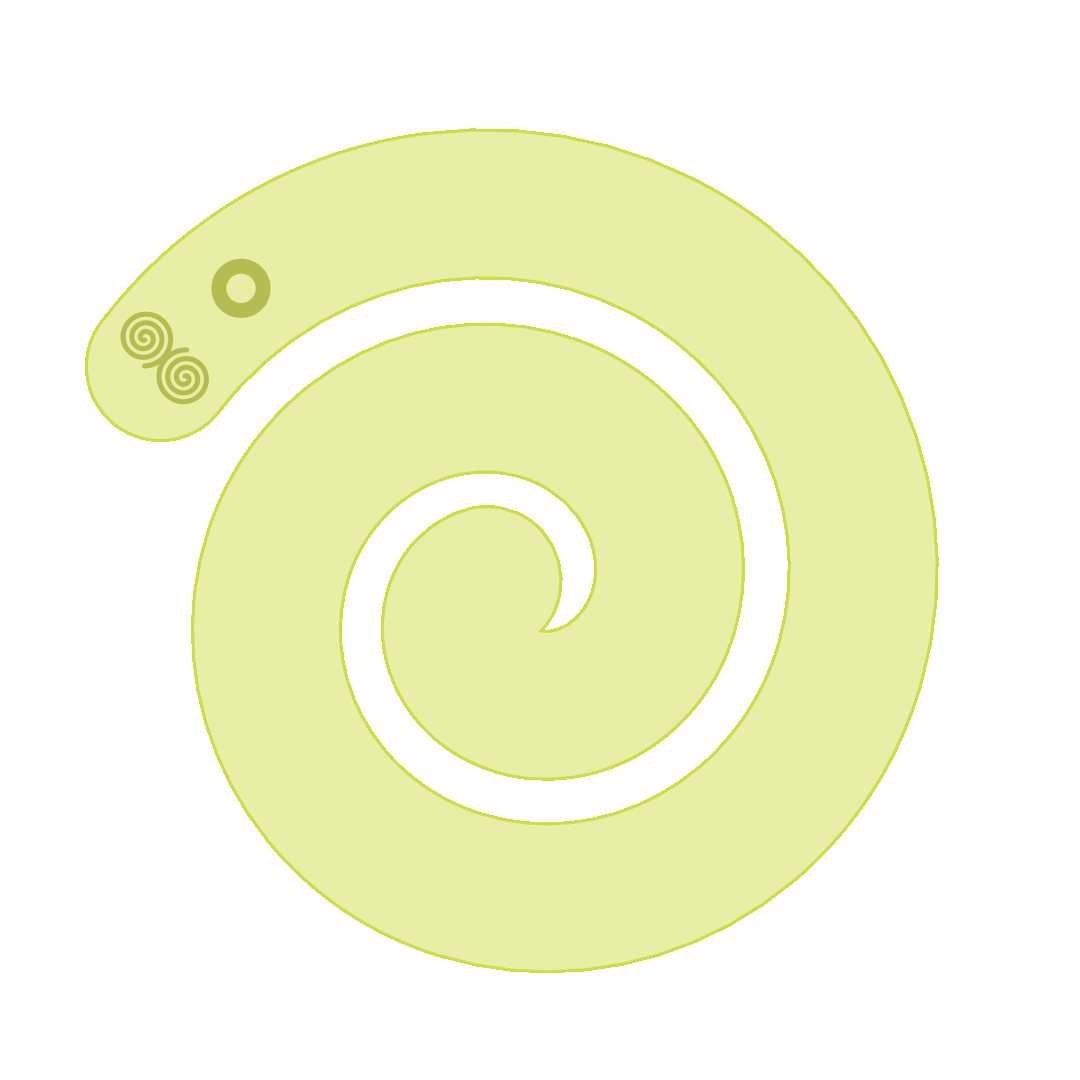
HOW TO
HAVE A
GOOD
NIGHT?
HOW TO
HAVE A
GOOD
NIGHT?
People who perpetrate violence can seek contact with others in clubs or bars – these can be casual acquaintances but can also be who we consider friends or lovers” and I would prefer it in the end after the tips on how to have a good night.
Given the variety of dynamics and possible scenarios, we’ve compiled the following general recommendations to make your club experience more enjoyable and safer:
Never give anyone substances unknowinglyor without their consent!
If something feels questionable, respond and be an active bystander.
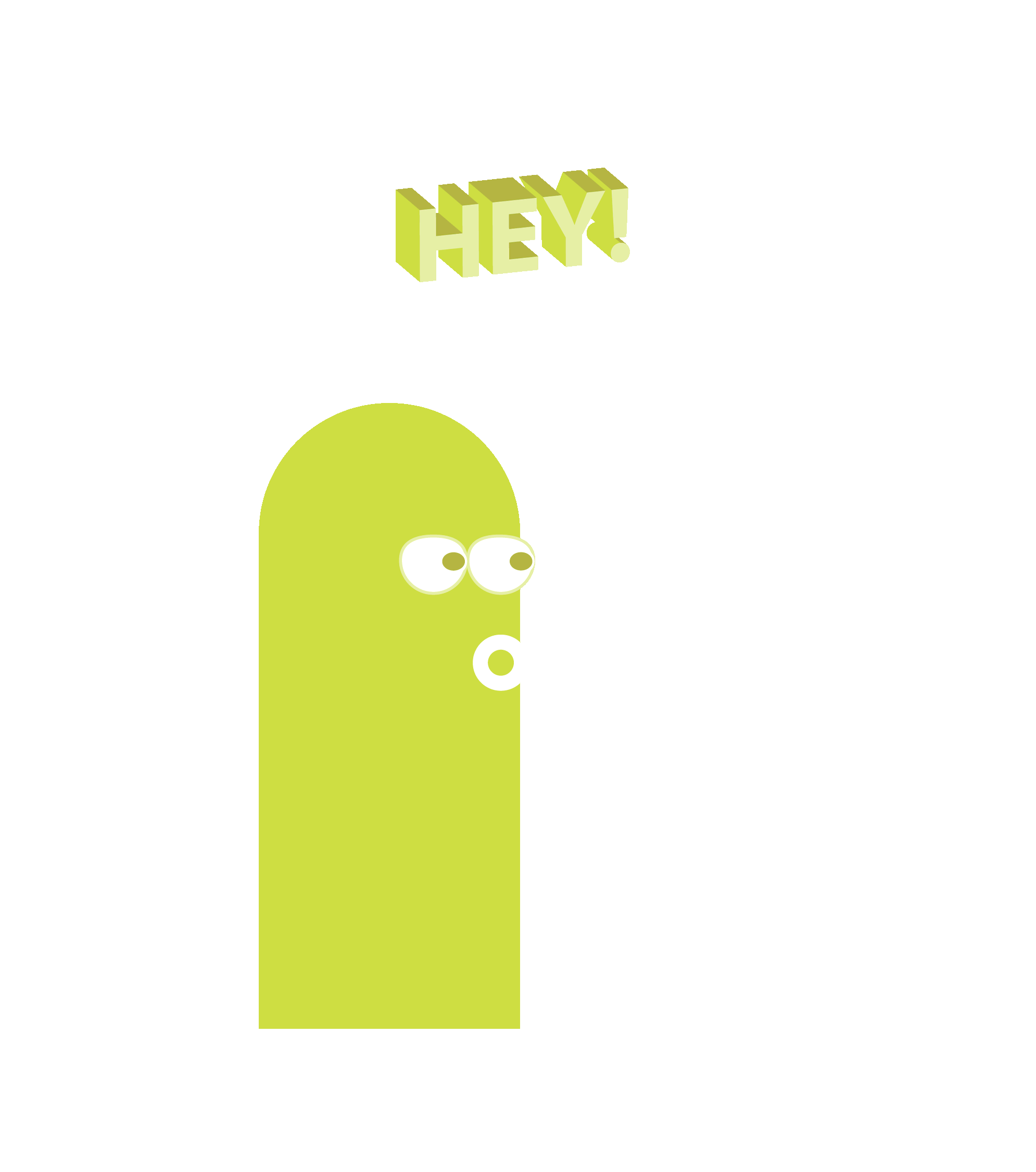
If you’re feeling unwell, don’t go home alone—reach out to friends or staff for support.
Don’t leave your drinks unattended.


Only accept drinks from strangers if you can see them being ordered, prepared, and handed to you at the bar.
Take care of people who seem to have consumed too much.
Trust your gut—step away from situations or people that feel off.
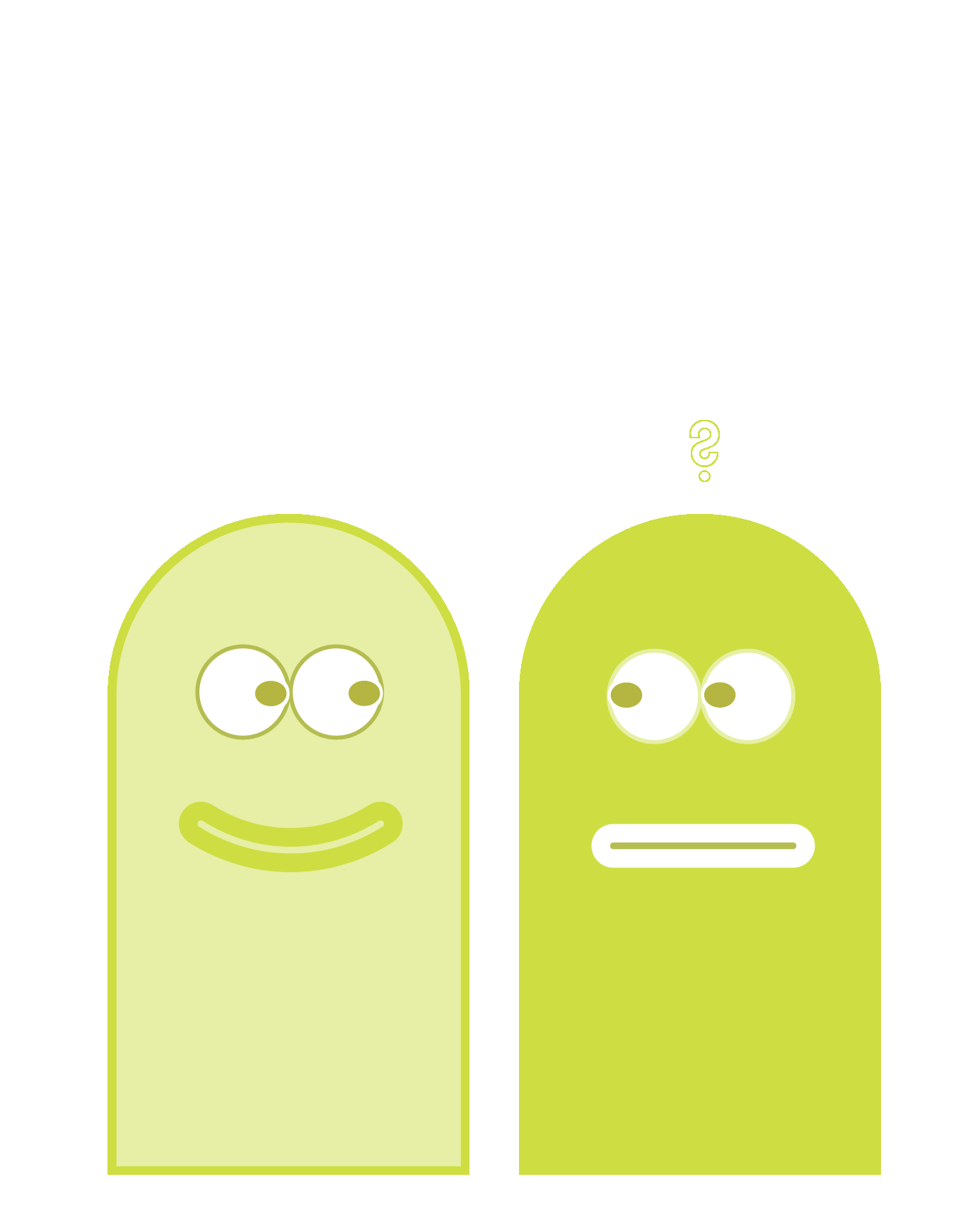
Go out with people you trust whenever possible.
Ask for consent! If there’s no clear “yes,” it’s a “no”.

Look out for each other, if something seems strange, pay extra attention.

It is NEVER okay to use substances to influence or manipulate others—even if it seems consensual!
Don’t hesitate to approach staff and ask for help in problematic situations.
POSTER CAMPAIGN
With the poster campaign HOW TO HAVE A GOOD NIGHT, we aim to draw attention to ways we can collectively create a safer and more enjoyable nightlife.
HAVE A GOOD NIGHT!
This approach to ᴀ ɢᴏᴏᴅ ɴɪɢʜ follows a holistic vision, where not only self-centered and hedonistic ideas – focused primarily on personal enjoyment – are prioritized. Instead, the emphasis is on collectively minimizing potentially harmful and violence-inducing dynamics while fostering mutual care. The goal is to maximize the potential for an especially wonderful night for as many people as possible at the same time.
NEIN, ICH HAB NICHT NUR ZU VIEL GETRUNKEN!NO, I DIDN’T JUST DRINK TOO MUCH!
ɴᴏ, ɪ ᴅɪᴅɴ’ᴛ ᴊᴜsᴛ ᴅʀɪɴᴋ ᴛᴏᴏ ᴍᴜᴄʜ! – we repeatedly receive reports that individuals affected by spiking incidents are not taken seriously enough, whether by the police or in hospitals. Comments such as "You probably just had too much to drink" perpetuate stigma, fear, and shame in those affected, while implying a sense of self-blame.
Spiking can also occur alongside voluntary consumption of substances, leading those affected to attribute memory gaps and physical symptoms to their own actions. Such assumptions and doubts about one’s perception are reinforced by these dismissive remarks. This results in fewer incidents being uncovered, and many people hesitate to seek professional help.
For those affected, it becomes even more difficult to process traumatizing experiences if they feel they have no one to turn to or are not believed by the responsible institutions.
Therefore, intensive efforts are needed to remove barriers to investigating suspected incidents. This must involve improving existing facilities and expanding specialized services, such as violence intervention units, staffed with personnel specifically trained in these matters. Additionally, access to comprehensive testing options must be ensured promptly and free of charge, regardless of location.
Moreover, we clearly need to have a more open conversation about another drug: alcohol. The risks associated with this often voluntarily and excessively consumed substance – which is sometimes also used as a spiking agent—are underestimated and frequently socially legitimized.
Show more
Show less

SAFER SPACES NOW!
Safer spaces are a fundamental part of creating a respectful and safer nightlife. Event organizers and bar or club owners have a responsibility to do their part in creating environments where violence in any form – whether physical, verbal, or structural – has no place. The goal is to foster an atmosphere centered on mutual respect, consideration, and the well-being of all guests.
A safer space is built through visible measures such as clear rules against violence and inappropriate behavior, trained and present staff, and secure structures within the venue. These include retreat areas and support points that provide assistance to those affected. Equally important is consistent communication: clubs and organizers must clearly signal their commitment to a respectful and violence-free environment.
By taking responsibility, event organizers and club operators create spaces where people can celebrate more freely. A safer space is a space defined by respect and mutual care, paving the way for a more enjoyable and secure nightlife.
Show more
Show less

THERE IS NO“I” IN RAVE
A Rave Is No Place for Egoism – "ᴛʜᴇʀᴇ ɪꜱɴᴏ 'ɪ' ɪɴ ʀᴀᴠᴇ" reminds us that parties and raves are collective experiences where the focus is on the “we” and the shared experience.
A good night isn’t just about how much fun you have as an individual, it’s also about how we, as a community, care for each other. It’s about moving away from self-centered attitudes and towards a culture that prioritizes mutual respect and consideration. By looking out for one another, we can create spaces that are welcoming to everyone, where no one feels excluded or uncomfortable.
Being an active bystander means paying attention to the dynamics around you and taking action when you witness something wrong. It’s about stepping in, supporting those affected, or getting help from staff – instead of looking the other way.
A rave is a place for togetherness – and together, we can make the most out of every night.
Show more
Show less

FINGER WEG!
ꜰɪɴɢᴇʀ ᴡᴇɢ! as in "hands off!" stands for respecting the autonomy and dignity of every person.
No one has the right to manipulate another person or undermine their freedom. Crossing boundaries – whether through substances or actions – is never acceptable. Those who deliberately interfere to exert control or disregard boundaries violate the trust and freedom that form the foundation of a safe community and bear full responsibility for their harmful actions.
A safer nightlife begins when everyone takes responsibility for their own actions while respecting the autonomy of others. Violence, manipulation, and assaults not only erode trust but also destroy the sense of community that defines parties and raves and can have legal consequences.
To anyone who may have crossed a boundary: it’s never too late to take responsibility and reflect on your behavior. Respect and consent are not burdens—they are the keys to genuine connections.
Show more
Show less

MY DRINK. MY NIGHT. MY CHOICE.
Every night belongs to you – and so does every decision you make along the way. Your drink, your pace, your enjoyment: it’s entirely in your hands.
How you choose to spend your night – what you wear, whether you drink alcohol or not, what and how much you consume, and how you end your night – is entirely up to you. None of these decisions require justification, and none of them give anyone else the right to interfere.
Boundaries are not negotiable, and setting them is not a weakness but a powerful expression of self-determination and strength. Respect means accepting the decisions of others without questioning them.
What to Do If You Are Affected
Even if your first instinct is to leave or go home – do not go alone or retreat to an unsafe location.
Avoid drinking more alcohol and, if possible, secure the suspicious drink.
Reach out to someone you trust, close friends, or event staff.
Make it clear that
immediate help is needed.
Move to a “safer” place within the venue to assess the situation and decide on the next steps.
If there’s no “safer” place available, stay in a public and busy area.
In case of emergency or worsening symptoms, don’t hesitate to call emergency services and possibly the police.
Check pulse and breathing – administer the recovery position if necessary.
Go to a doctor or hospital as soon as possible for initial treatment and further examination.
Inform medical professionals of the suspicion that incapacitating substances may have been used.
Urine and blood tests can only detect these substances for a short time. Don’t worry if other substances were consumed – medical staff are bound by confidentiality.
If immediate medical care is not possible or desired, ensure evidence by collecting a urine sample (use a clean container and keep it refrigerated).
If Sexualized Violence Is Suspected After Spiking
Seek medical attention as quickly as possible.
Inform medical professionals of your suspicion of spiking.
If you’re feeling unwell, don’t go home alone—reach out to friends or staff for support.
Only accept drinks from strangers if you can see them being ordered, prepared, and handed to you at the bar.
Even though it may be difficult, avoid showering or changing your clothes (or keep them unwashed). This can remove critical evidence.
If medical care isn’t immediately available, collect a urine sample yourself.
Substances are best detected in the first urine of the morning.
Any evidence collected during tests can be used for a report later, even if you decide not to take immediate action.
Since this is a criminal act, the police should be informed. If you’re uncomfortable doing so, other support services can assist you.
Legal and Detectability
The surreptitious administration of substances or other psychoactive drugs constitutes bodily harm and is a criminal offense.
However, reliable statistics on how many people are affected annually are difficult to obtain due to the limited detectability of these substances and often unclear circumstances. Victims often feel weak, confused, and experience significant memory gaps, which can lead them to blame themselves. Unfortunately, only a small fraction of these incidents are reported to the police or medically examined, and by the time tests are conducted, the substances are often no longer detectable.
It is crucial to understand that most used substances can only be detected in urine or blood for a few hours. For instance, GHB can be detected for up to a maximum of 12 hours after ingestion or administration, depending on the dosage. Feelings of shame and trauma further contribute to the underreporting of these incidents.
We strongly encourage anyone who suspects they have been affected to seek medical attention as quickly as possible. The immediate collection and toxicological analysis of urine samples should be standard practice and a top priority in uncovering spiking incidents.
Show more
Show less

.gif)


.png)
